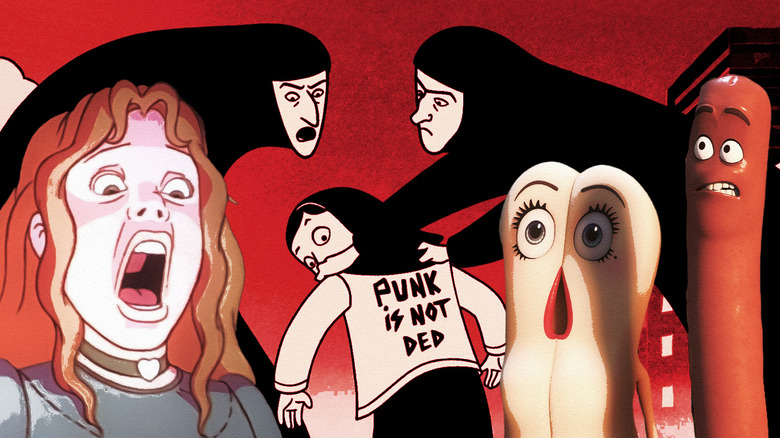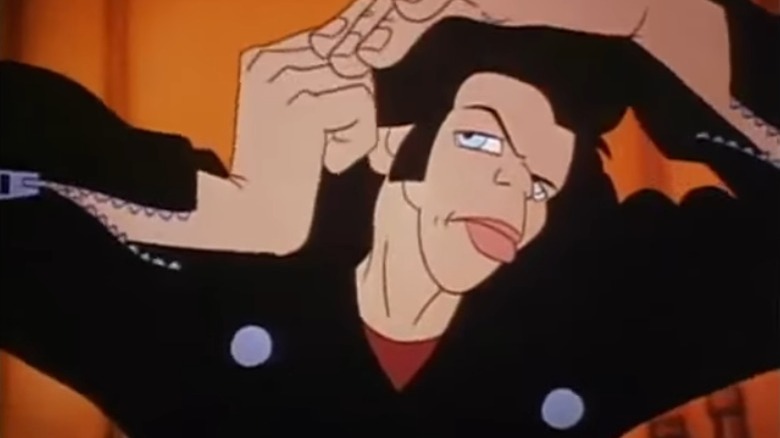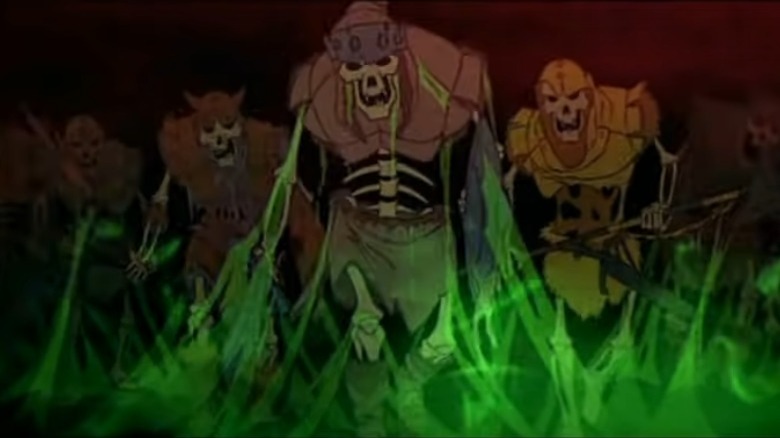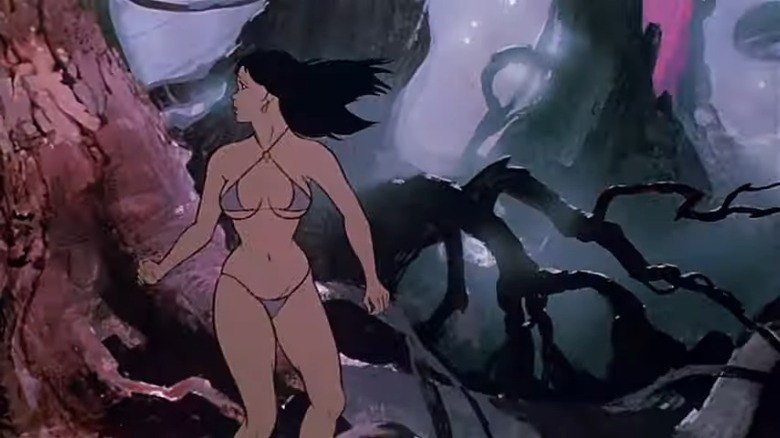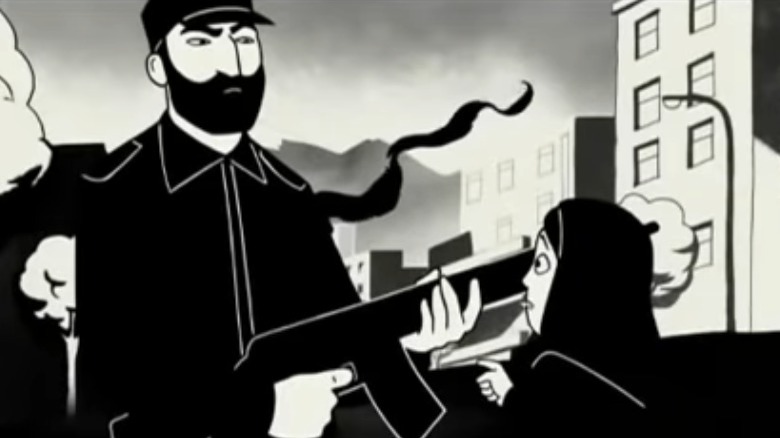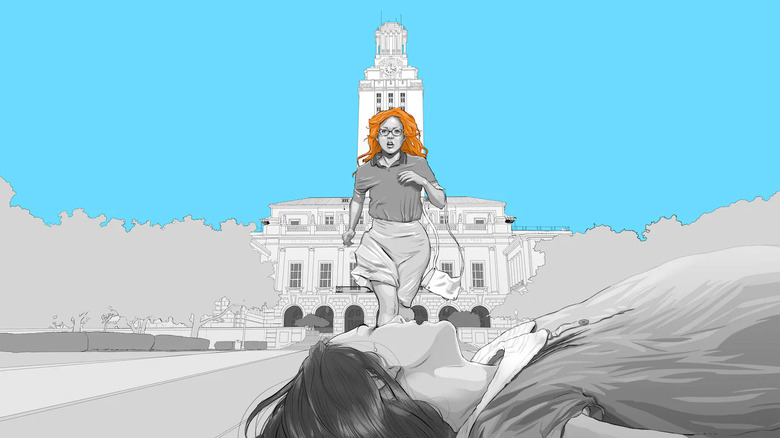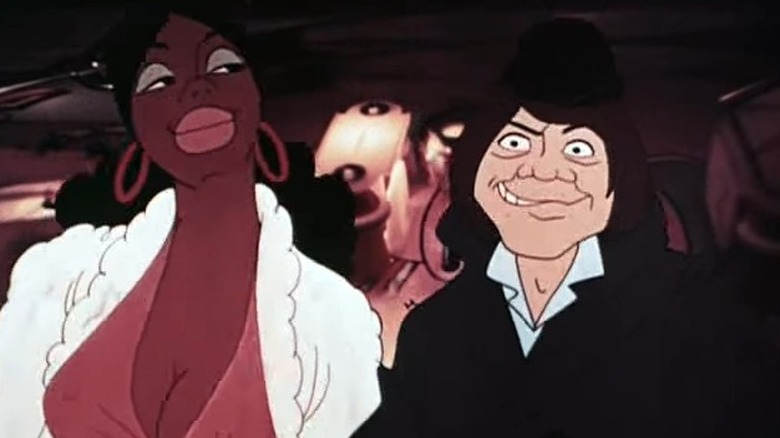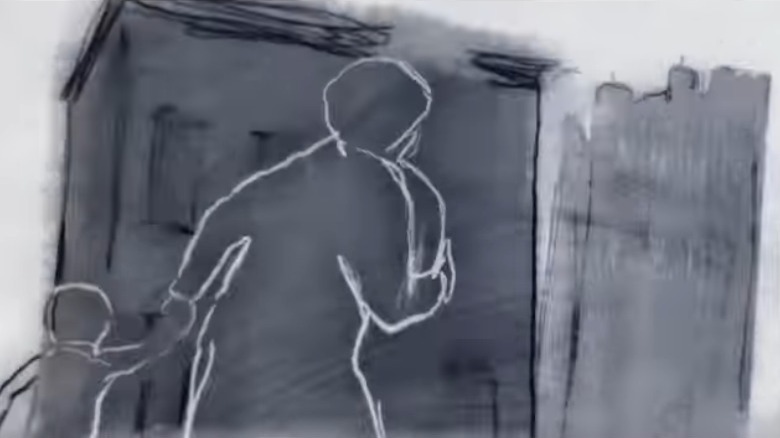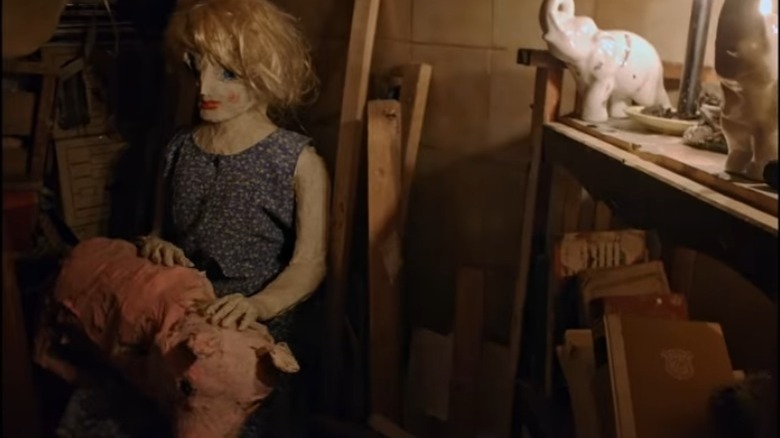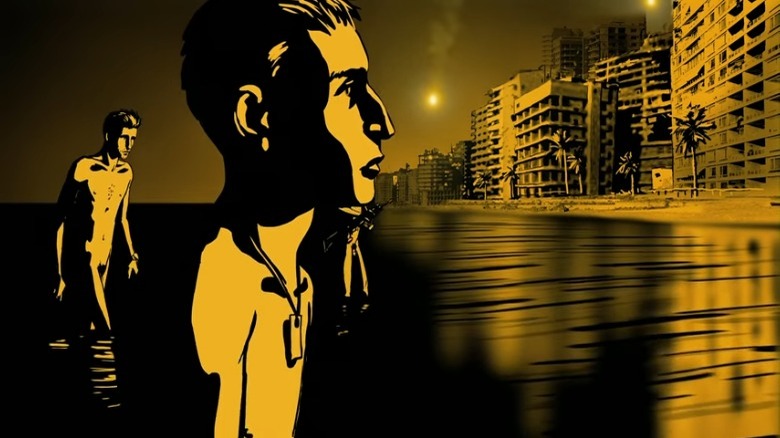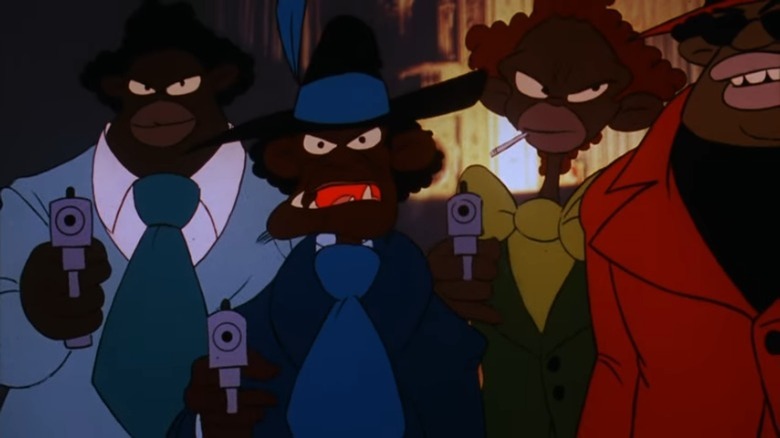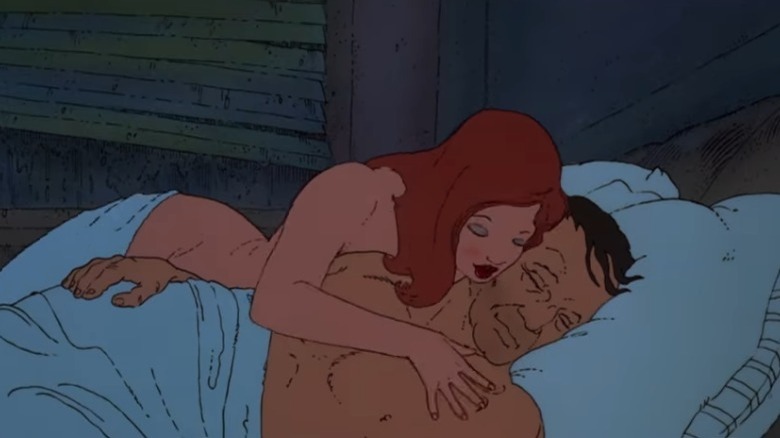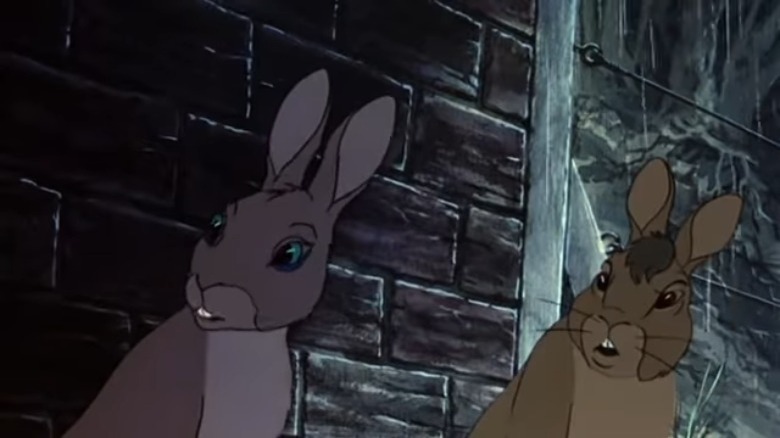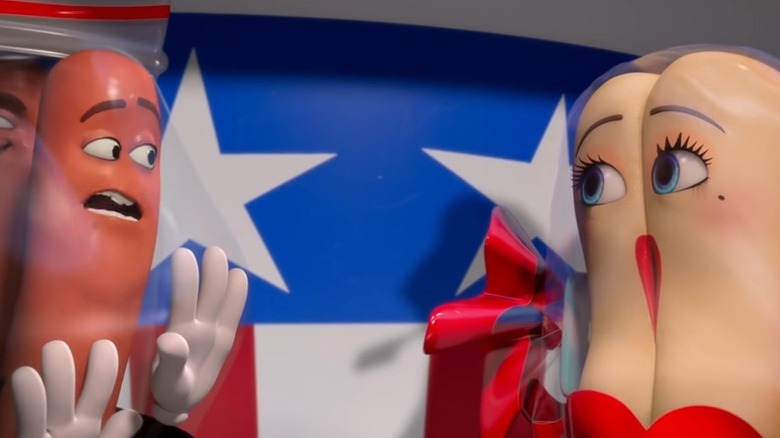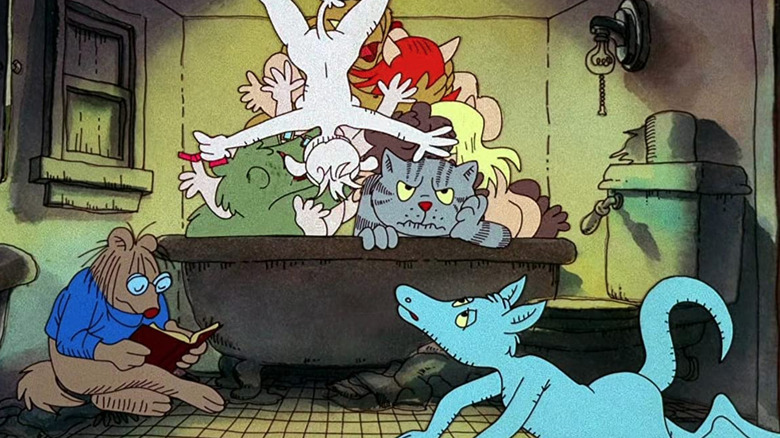The Best Animated Movies No Child Should Ever See
Ever since Walt Disney released "Snow White and the Seven Dwarfs" in 1937, animation has played a significant role in popular culture. Disney animated films have long been the leader in the medium, even as they've transitioned from 2D cel animation to modern 3D CGI (with great help from a key Pixar acquisition) and for the most part, the company's films have been targeted at children. Because of this, animated films having become largely synonymous with the pig-tailed, Goldfish-cracker-loving set; but not all animated films are appropriate viewing for all ages.
Sure, animation remains a go-to way to entertain kids for a couple of hours, but like any medium, it can tell all sorts of stories. After all, while "Snow White" may have been the first full-length animated feature film, it entered popular culture a full 29 years after Émile Cohl's silent short "Fantasmagorie." was created. Looking back at the evolution of the medium today, more than a century of animated stories have resulted in a plethora of shorts, episodes, and movies — many as powerful, mature and thought-provoking as any live action experience, many aimed squarely at an adult audience.
There are entire genres of Japanese anime that fit this description and deserve acknowledgement, but plenty of animation in the west was designed for adults as well. After all, animation, like any art form, isn't just for kids.
It's not uncommon for kids to watch these movies before they're mature enough to handle them; anyone who grew up with a particular film about bunny rabbits and been emotionally scarred for life can attest to that. Here are some additional films that rank among the greatest feats of animation, but under no circumstances should be viewed by children.
Hey Good Lookin' (1982)
"Hey Good Lookin'" is a Ralph Bakshi film — which should tell you three things: it's visually impressive, more than a bit risque, and endured a significant development hell. This time around, that was largely due to Bakshi's then-cutting-edge desire to integrate live-action and animation, something typically only seen in small amounts before the days of "Who Framed Roger Rabbit?"
The Bakshi project was also unlike other efforts which blended techniques in its determination to have the characters interact. Bakshi would later largely achieve this (albeit in a film most viewed as underwhelming) with "Cool World," but the impact of "Hey Good Lookin'" was largely undercut by an impatient studio that re-cut the film to include far fewer live-action sequences and different dialogue. While the original edit was never released, "Hey Good Lookin'" made it to theaters in 1982 and was somewhat well-received.
The film is centered around Vinnie, the leader of a greaser gang called the Stompers, and is set in 1950s Brooklyn. Throughout the film, Vinnie is caught up in gang violence and interactions with other gangs. There is also quite a bit of violence, drinking, and, like much of Bakshi's work, offensive caricatures of Black Americans that rely heavily on negative stereotypes.
Although the film was saved from an X-rating, it was still rated R by the MPAA, rendering it largely (and mercifully) inaccessible for young audiences. While "Hey Good Lookin'" is far from Bakshi's greatest film, it remains a fascinating depiction of his style, and has become something of a cult classic.
The Black Cauldron (1985)
If you thought all Disney movies were rated G, you must have missed out on "The Black Cauldron" when it hit theaters in 1985. The film is based on Lloyd Alexander's "The Chronicles of Prydain" and differs from other animated films made by the House of Mouse. Keep in mind, the '70s to mid-'80s was a dark time (quite literally) for Disney productions, as the company navigated a post-Walt landscape, flirted with older-skewing fare like "The Black Hole" and "Midnight Madness," and wouldn't take back the kiddie crown until "The Little Mermaid" in 1989. As such, "Cauldron" was another departure from classic fairy tales Disney relied on for decades, and serious nightmare fuel.
On the one hand, it has many of the trappings of a Disney animated film: A princess, a hero, a villain, and magic. On the other hand, the villain is the frightening Horned King, who seeks the Black Cauldron so he can raise an undead army and wreak havoc across the land. While most of the movie is relatively light on horrific elements, the raising of a skeleton army was a lot to handle for young children. "The Black Cauldron" was a costly gamble for Disney, and its failure nearly killed the company. There's a reason the Disney Renaissance saw a return to form a few years later — as bold as experiments like "Cauldron" had been, it needed saving.
In the years since the film's release, it has become a minor cult classic. While its visuals are perhaps less frightening than what modern children are exposed to, seeing this film in the theaters in 1985 was enough to make a lot of kids hide in their popcorn buckets. Disney didn't release it on home video for 13 years, so it's no wonder today that Princess Eilonwy isn't a recognized Disney Princess.
Fire and Ice (1983)
"Fire and Ice" is an epic fantasy film created by Bakshi and Frank Frazetta, whose art style is featured throughout the movie. The film was made at a time when fantasy films were doing good business, and Bakshi was eager to get in on the genre.
Set after the last ice age ends, as an evil queen launches a campaign with her son to conquer the world, the film tells the tale of those in opposition, primarily the sole survivor of a village destroyed by glaciers and the King of Firekeep.
"Fire and Ice" received a PG rating from the MPAA — but had it been released a year later, it likely would have been given a PG-13. That rating went into effect following parental backlash to films like "Indiana Jones and the Temple of Doom" (per The Hollywood Reporter). With similarly violent and racy content, there's little doubt "Fire and Ice" would have been deemed inappropriate for children under 13 had the MPAA had PG-13 at its disposal.
The film features a great deal of violence, sexual innuendo, and skimpy clothing on most of its characters. After all, Frazetta had a successful career emphasizing the sexualization of men and women, and "Fire and Ice" is no exception. The film was made via rotoscoping, animating live-action sequences shot and directed by Bakshi and Frazetta. While it wasn't a successful film upon release, it is another cult classic, primarily for fans of Bakshi and Frazetta.
Persepolis (2007)
An Oscar-nominated adaptation of Marjane Satrapi's graphic novel based on her life and experiences growing up in Iran during the Islamic Revolution, the animation style of "Persepolis" is unusual in its simplicity, as it used traditional animation techniques, even after CGI was readily available. The filmmakers worked closely with Satrapi to achieve her vision, necessitating a less detailed depiction of her story to avoid looking dated. The animators achieved this by focusing on depictions of people in a more natural interpretation.
The film follows Marjane, who was born to a progressive middle-class family, living freely until the age of nine, when the Revolution began. As an outspoken and imaginative young woman, Marjane finds adapting to the new way of things difficult, and she ultimately leaves Iran for Vienna, Austria. She experiments with sex and drugs and comes close to suicide after a difficult period of homelessness. The film focuses on Marjene's coming-of-age amidst the backdrop of religious fundamentalism, life without her family, and her fight for independence.
Because the story is focused on life in pre- and post-revolutionary Iran, there are numerous depictions of violence, sex, suicide, and drug use. While scenes involving executions by firing squad and hangings are (arguably) less gruesome than they could be due to the abstract, black-and-white visuals, the film's target audience was never intended to include children. In the U.S., the film is rated PG-13, though Common Sense Media suggests only those 15 and older should view the film.
If you or anyone you know is having suicidal thoughts, please call the National Suicide Prevention Lifeline by dialing 988 or by calling 1-800-273-TALK (8255).
Tower (2016)
A riveting documentary film primarily placing animated recreation over live-action backgrounds and actual audio from a horrific tragedy, "Tower" unfolds the tale of the 1966 shootings at the University of Texas at Austin, where Charles Whitman perched himself at the top of the university clock tower and opened fire, killing 16 and wounding dozens of bystanders. The film succeeds in its goal of making the viewer feel as if you were there on that terrible day; the shooting went on for some 96 minutes, and while it wasn't the first mass shooting in the U.S., it is recognized today as being an early example of such violence in modern times.
The film's visuals combine a mix of styles, with much of it focused on rotoscoping, which involves painting each frame by tracing live-action footage. This animation method adds realism to the film by expressing archival footage in a new, dramatic manner. The filmmakers worked closely with the Texas Archive of the Moving Image to capture the story of the shooting and its aftermath. When live-action footage is used, it's meant to jolt the viewer from the relative comfort of animation into the stark reality of the event.
Given its subject matter, "Tower" is most certainly not intended for children. That said, it's a stark reminder of something children have to deal with far too often today: school shootings. As a result, while young children shouldn't view it, Common Sense Media's review of "Tower" indicates it is appropriate for children 14 and older. The MPAA has not rated the film.
Heavy Traffic (1973)
"Heavy Traffic" combines live-action and animation in a story that explores life in New York City. Much of the art style varies from scene to scene, and the film utilized various experimental techniques, including using blurred photographs of New York City in the background of each scene. "Heavy Traffic" was written and directed by Bakshi, whose only foray into children's animation had previously come via "Mighty Mouse" cartoons. His work is decidedly adult-oriented, and "Heavy Traffic" is his most critically successful film.
The central character is a cartoonist named Michael Corleone, a 24-year-old man obsessed with pinball. Throughout the film, pinball is used as a metaphor for life and plays prominently in many scenes. Whenever Michael plays pinball, he asks himself philosophical questions, which are then played out via animation. Scenes from his life depict his family problems, cartoonist skills, domestic issues, mafia run-ins, crime, sex, violence, and prostitution. It all plays out through his imagination while playing pinball, and it's fascinating to watch.
But the film did receive an X-rating from the MPAA; while it did well upon release, it was then edited to an R-rating and re-released the following year. "Heavy Traffic" is, in no way, intended for children and a product of its time, as depictions of Italians and African Americans are stereotypically negative. Additionally, it's full of sex, innuendo, and violence and was released with the tagline: "It's animated, but it's not a cartoon. It's funny, but it's not a comedy. It's real. It's unreal. It's heavy."
Flee (2021)
"Flee" is a documentary film that tells the story of Amin Nawabi. It begins with Amin being interviewed in Denmark by a close friend who wants to know about his past, for a documentary he is filming. Amin tells his story, beginning as a child in Afghanistan, where he often hid from authorities to avoid being drafted into the Afghan-Soviet war. Throughout the film, Amin explains how he and his family managed to escape to Russia, were separated as they paid human traffickers to take them to Sweden, and their close calls throughout this time.
Amin's story is heartbreaking and connects to his current situation as the film cuts between flashbacks and the present. Amin's boyfriend wants him to remain in Denmark, but Amin, who has difficulty staying in one place for long, wants to move to the U.S. to work at Princeton University. They separate but later reunite and marry. The film depicts a story not typically discussed in the west, and it casts light on the struggles of ordinary people who become refugees and the challenges they face in war-torn parts of the world.
While the film cuts to archival footage to make a point, the animation style is meticulously detailed. The animators used brushstrokes to give the animation the look and feel of a graphic novel, making it look more mature than traditional animation. "Flee" features numerous adult themes and coarse language, making it appropriate for children 14 and older, per Common Sense Media.
The Wolf House (2018)
Stop-motion animation has long been used for telling stories related to action, adventure, and horror. Films like "King Kong" and "Clash of the Titans" relied heavily on the technique, and the work of pioneers like Ray Harryhausen are landmarks in Hollywood history. But few stop-motion films stray into horror as expertly as "The Wolf House." The film centers around María, who escapes from a colony of German religious zealots to a small house in Chile. The home is occupied by two pigs who welcome María, and as the film progresses, the house changes.
María's emotions have a literal impact on the house and its inhabitants. The pigs transform into people, and the house becomes a hellscape of fearful imagery. The animation is done via stop-motion, but it incorporates 2D illustrations and painting into the background as the evolving setting morphs from one emotional state to the next. It's innovative, ridiculously creepy, and a brilliant example of experimental animation techniques.
Much of "The Wolf House" imagery is metaphorical and strange. The MPAA hasn't rated the film, but it should not be shown to children. The imagery is nuanced and is appreciable by adults, but for kids, it's little more than nightmare fuel that will ensure restful sleep is a rare experience for some time. For adults, it's a brilliant film that explores the semi-fictionalized account of Colonia Dignidad under Nazi Paul Schäfer's rule, as well as the torturous handling of the children of his community by none other than the Angel of Death, Dr. Joseph Mengele.
Waltz with Bashir (2008)
The Oscar-nominated "Waltz with Bashir" is an animated documentary focusing on the 1982 Lebanon War and Israel's participation in the Sabra and Shatila massacre. The film's animation is similar to that of "Persepolis" in that it's designed to approximate the look of comics. The animation combines traditional 2D animation with realistic graphics and archival footage. The documentary is unusual for its widespread use of animation, with very little live-action archival footage seen throughout the film.
The story focuses on Ari Folman, an infantry soldier in the Israel Defense Forces during the conflict. Ari has no memories of his time during the war, so he seeks help from a therapist. As he uncovers his deeply-hidden traumas, he recalls being in the unit that deployed flares in support of the Lebanese Phalange militia, which carried out the massacre. Ari suppressed his memories to disassociate himself and his actions from the horrors he witnessed. The film concludes with the animation dissolving into archival footage of the massacre's aftermath.
"Waltz with Bashir" is a disturbingly real account of a soldier's trauma-induced PTSD as it relates specifically to guilt. Moreover, it's a detailed account of a massacre and the shame carried by a man who unknowingly supported it. Roger Ebert described the film as "a tortured reconstruction of an uncertain past." The sex and graphic violence earned the film an R rating. It's essential viewing for adults, but a pass for children under the age of 17, per Common Sense Media.
Coonskin (1975)
If the title doesn't clue you in already, "Coonskin" is not a movie to watch with your kids around. It's also largely remembered today as having derailed Bakshi's "Hey Good Lookin'" due to its icy reception from the public. On the surface, "Coonskin" looks like the most racist movie since "The Birth of a Nation," but it's the opposite. The film satirizes blaxploitation films popular in the 1970s ("Shaft, "Superfly") as well as Disney's "Song of the South," which has its own racial sensitivity issues. When "Coonskin" was released, it was dubbed "racist" (per The New York Times); in the years since, it has been reinterpreted as a condemnation of racism.
"Coonskin" focuses on a rabbit, a fox, and a bear, all depicted as African American. They work to rise to the top of Harlem's mob and encounter corrupt cops, grifters, and Mafioso. Like much of Bakshi's work in the '70s, the film incorporated live-action and animated sequences to tell its story. "Coonskin" makes several references to African American stereotypes, as well as the "Uncle Remus" folktales that served as the basis for longtime Disney third-rail "Song of the South."
Watching this movie requires a suspension of outrage, since it frequently comes across as antithetical to its true purpose. While it is undoubtedly a product of its time, the message is universal and timeless. What appears as a racist depiction of African Americans is meant to be a social commentary on the negative impacts of stereotypes on the culture. As Roger Ebert wrote in his 1975 review, "by using caricatures and stereotypes so outrageously, Bakshi forces us to SEE them."
Heavy Metal (1981)
"Heavy Metal" is an animated anthology film that interweaves seemingly disparate vignettes with an evil force called the Loc-Nar. Each segment features some of the greatest heavy metal hits ever recorded up to 1981, and the soundtrack is phenomenal. The film was adapted from the magazine of the same name and features stories taken directly from the page.
When the film begins, the Loc-Nar annihilates an astronaut who arrives home aboard a flying 1960 Corvette. The Loc-Nar introduces itself to the man's daughter as "the sum of all evils" and proceeds to tell her stories of its influence. Each segment features the Loc-Nar in some way, as it ties the stories together — loosely. The vignettes are a mixture of science fiction, horror, and fantasy genres. The fantasy segment, centered around Den, sees a young boy transported to a fantasy realm in the body of a man. He proceeds to have sex with numerous women — essentially living out most teenage boys' fantasies. Den becomes entangled in a war with both sides, hoping to steal the Loc-Nar.
"Heavy Metal" is an early example of high-profile actors voicing animated characters, with a cast including John Candy, Eugene Levy, Al Waxman, and more. The film was appropriately rated R due to the violence and drug use, and there's quite a bit of sex as well. A sequel, "Heavy Metal 2000," is equally inappropriate, though it didn't have the cultural impact as its predecessor. These days "Heavy Metal" remains a beloved cult classic by adult fans worldwide.
Watership Down (1978)
"Watership Down" is one of those movies that well-meaning parents accidentally exposed their children to in the 1980s. After all, the VHS tape featured animated bunnies on the cover, so why wouldn't that be appropriate for children?
Now-adults who recall watching the film during the Decade of Greed likely recall its horrific nature and violent imagery as something to which no children should be subjected. The film is based on Richard Adams' novel of the same name, centering around a warren of rabbits in Berkshire, England.
The story focuses on the rabbit's theology and understanding of the world. A rabbit named Fiver is a seer who has an apocalyptic vision of the destruction of the warren, which he tries (and fails) to save. Only a handful of rabbits escape, and after a perilous adventure, they find Watership Down, a hill Fiver saw in his vision, and settle there. Before long, they are discovered by a ruthless warren of Efrafan rabbits, and they go to bloody war with one another.
The film's success comes from its structure, ensuring the audience sees the world from a rabbit's point of view. Sadly, while the movie is exceptional, it has an unfortunate legacy. Ed Power of the Independent described it as a film that "terrified an entire generation." This was especially true in the U.K., which for some reason rated the film as U, or universal (appropriate for all ages). Nevertheless, even by today's standards the film remains decidedly not suitable for children under 11.
Sausage Party (2016)
"Sausage Party" is a CGI film from the minds of Seth Rogen, Evan Goldberg, and others. The movie anthropomorphizes food in a grocery store, where everyone believes the best thing in life is to be purchased. Of course, the food doesn't realize that people are taking them home to eat them, building a false theology — and leading to much humor centered around sex, drugs and quasi-cannibalism.
The film centers around a hot dog, appropriately named Frank. He dreams of the "Great Beyond," where food goes when it leaves the store. Throughout the movie, he learns the truth and builds a group of friends who seek to change their fate.
If that's all you know of "Sausage Party," you might think it's an appropriate movie for children, but you would be wrong. The film is entirely adult-oriented, and there's so much sexual innuendo spread throughout, it's hardly innuendo. Frank is infatuated with his girlfriend, Brenda, who is a hot dog bun. That's certainly appropriate, but's also a touch obvious. Regardless, the film relies heavily on comedy and the overt sexualization of food.
The movie ends with an all-out orgy, which pretty much says it all, where showing the film to kids is concerned. Common Sense Media called the film "Funny but filthy" and noted a great deal of sex and profanity. The film is rated R, but consideration should be taken before showing it to anyone under the age of 18. Unsurprisingly, it took Rogen eight years to make because of such content (via Variety).
Fritz the Cat (1972)
The grandaddy of all films inappropriate for children, "Fritz the Cat" is based on Robert Crumb's comic strip of the same name, published in numerous magazines and underground comics of the late-'60s and early 1970s. Fritz is a womanizing cat living in a grimy New York City peopled by anthropomorphic animals. The film focuses on leftist causes by satirizing the counterculture political revolution running rampant in the United States at the time. The film was one of the earliest examples of adult-oriented animation, which writer/director Bakshi (here making his directorial debut) helped pioneer.
In the film, Fritz drops out of college, causes a race riot, and has a lot of sex. The satirical nature of the film's depiction of the free love movement and the era, in general, differed from Crumb's vision, and so he hated the movie. The year it was released, he killed the character in his strip and became disillusioned with such adaptations. Before "Fritz the Cat," animation was primarily about entertaining children, but Bakshi changed all that, and the film became the first animated movie to receive an X-rating.
Instead of balking at the rating, Bakshi embraced it, putting "We're not rated X for nothin', baby!" and "He's X rated and animated!" on the film's posters. The movie would become incredibly controversial, but also successful, as its reputation brought in audiences curious about what an X-rated animated movie would be like. "Fritz the Cat" was wildly successful, and it helped broaden the medium for adult-oriented stories. While it focuses heavily on sex, drugs, and the counterculture, today the impact of "Fritz the Cat" on popular culture — and what the medium of animation could achieve — is undeniable.
